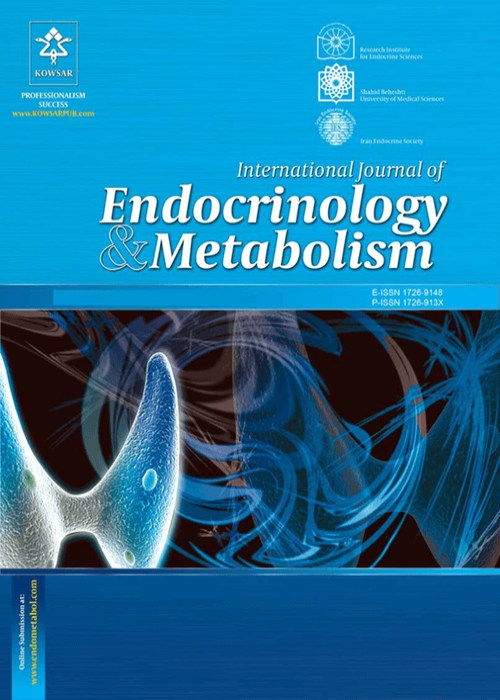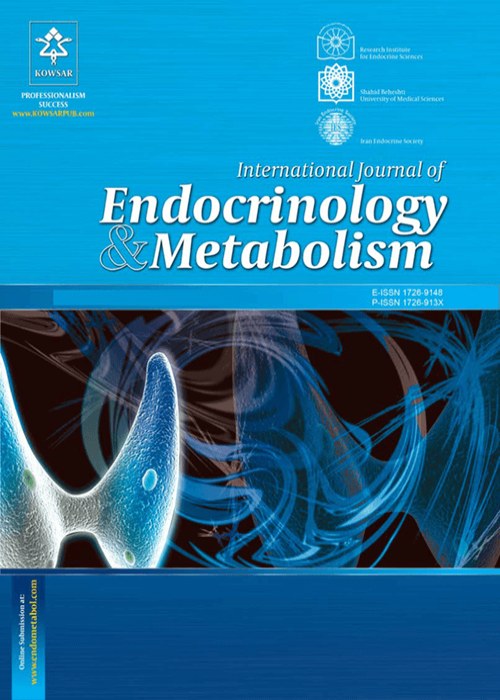فهرست مطالب

International Journal of Endocrinology and Metabolism
Volume:21 Issue: 2, Apr 2023
- تاریخ انتشار: 1402/02/02
- تعداد عناوین: 6
-
-
Page 1Background
Calorie restriction without malnutrition is likely to improve cardiovascular risk factors.
ObjectivesThe aim of this study was to investigate calorie restriction on markers of cardiometabolic risk in overweight/obese adults with cardiovascular risk factors.
MethodsIn a parallel controlled trial, patients with overweight or obesity and one or more cardiovascular risk factor were randomized to a modest reduced-calorie diet (75% of the total calculated energy requirements) or control (no calorie restriction) groups and followed up for two months. Body weight, dietary intake, fasting plasma levels of C-reactive protein (CRP), monocyte chemoattractant protein-1 (MCP-1), intercellular adhesion molecule 1 (ICAM-1), vascular cell adhesion molecule 1 (VCAM-1), brain-derived neurotrophic factor (BDNF), neuropeptide Y (NPY), lipids, and glycemic factors were measured at baseline, and after two months. The differences were analyzed with analysis of covariance (ANCOVA).
ResultsSixty-six participants (33 in each group) completed the study. Body weight changed in the reduced-calorie diet group (- 3.05 ± 2.65 kg), and blood pressure was improved (systolic -6.96 ± 12.04 and diastolic - 3.90 ± 8.97 mmHg). The reduced-calorie diet improved plasma ICAM-1 (change from baseline - 0.45 ± 1.99 ng/mL, P = 0.033, ANCOVA), MCP-1 (change from baseline - 0.50 pg/mL, P = 0.011, ANCOVA), low-density lipoprotein cholesterol (change from baseline - 9.35 ± 19.61 mg/dL, P < 0.001, ANCOVA), and triglyceride (change from baseline -33.66 ± 49.08, P = 0.001, ANCOVA), but BDNF, NPY, and other cardiometabolic factors were not different.
ConclusionsIn overweight/obese subjects with cardiovascular risk factors which have been under medical treatment with risk-reducing medications, a modest weight loss induced by a reduced-calorie diet improved lipid profile, blood pressure, and reduced ICAM-1 and MCP-1 levels but had no effect on plasma BDNF or glycemic factors.
Keywords: Calorie-Restriction, Obesity, Cardiometabolic -
Page 2Introduction
Ganglioneuromas are tumors of neurogenic origin usually located in the abdomen, the adrenal glands, and the mediastinum but infrequently found in the neck region.
Case PresentationWe describe the case of a four-year-old Albanian girl presenting with an anterior neck mass initially suspected to be a thyroid nodule. From a clinical point of view, there was no evidence of compression on vital cervical structures. Lab tests detected normal serum thyrotropin, calcitonin, and parathormone concentrations. A neck ultrasound showed a huge mass apparently originating from the left thyroid lobe. Cytological examination of fine needle biopsy demonstrated a population of large cells with eosinophilic cytoplasm, regular nuclei, and prominent nucleoli and spindle cells without significant atypia, consistent with a benign lesion of neurogenic origin. Also, the neck MRI displayed a mass with well-defined margins, likely arising from the peripheral nervous system. The patient underwent surgical excision of the mass without complications. The histological exam was diagnostic for ganglioneuroma.
ConclusionsWe discuss the cytological and histological features peculiar to such a rare neck lesion and review the differential diagnosis.
Keywords: Ganglioneuroma, Neck, Childhood -
Page 3Background
Coronavirus disease 2019 (COVID-19) has spread quickly. Comorbidities, such as diabetes, have been determined as critical risk factors for COVID-19.
ObjectivesThis study aimed to determine the frequency and severity of diabetic ketoacidosis (DKA) in children before and during the COVID-19 pandemic.
MethodsThis retrospective study examined children aged less than 18 years diagnosed with DKA hospitalized in Yazd Shahid Sadoughi Hospital from February 20, 2020, to November 21, 2021. The collected information was compared to those obtained during the same period in 2019 (pre-pandemic). According to the inclusion criteria, only children with suspected symptoms of COVID-19 or an infected family member underwent PCR.
ResultsThe study included 70 children with confirmed DKA during the COVID-19 pandemic and 33 children hospitalized during the pre-pandemic period. The findings showed that the rate of DKA was higher during the pandemic than in the pre-pandemic period. In the DKA subgroups (during the COVID-19 pandemic vs. pre-pandemic), 35.7% vs. 21.2% were severe, 37.1% vs. 36.4% were moderate, and 27.1% vs. 42.4% were mild. Of 70 children, 30 underwent PCR tests for COVID-19, showing six positive cases. Among positive cases, five had mild symptoms, while one was hospitalized with signs of respiratory distress, polyuria, and polydipsia. All physical examinations of this patient were normal, except for the chest exam.
ConclusionsA remarkable increase was observed in the frequency and severity of DKA in children during the pandemic.
Keywords: Diabetic Ketoacidosis, SARS-CoV-2, Children, COVID-19 -
Page 4Background
Male infertility is a growing health problem. It is proposed that infertility is associated with some metabolic abnormalities.
ObjectivesThis study aimed to examine the prevalence of self-reported male infertility and related metabolic disturbances.
MethodsThis is a cross-sectional analysis of the Tehran Lipid and Glucose Study (TLGS). A total of 1526 males participated in the study. Logistic regression was used to examine metabolic factors associated with self-reported male infertility.
ResultsThe total prevalence of self-reported male infertility was 6.42%. Themean(SD) body mass index (BMI) of participantsamong fertile and infertile males was 26.80 (3.93) and 26.92 (4.36), respectively. The majority of participants in both groups were in the age group of 40-50 years old. In the fully adjusted model, the odds of infertility were significantly increased by each unit increase in total cholesterol [TC; odds ratio (OR), 1.01; 95% CI, 1.01 - 1.01; P = 0.03] and hip circumference (HC; OR, 1.06; 95% CI, 1.00 - 1.12; P = 0.02), respectively.
ConclusionsThe prevalence of self-reported male infertility was 6.42%. Male infertility was positively associated with TC and HC, indicating that knowledge about these risks might assist health care professionals and governments in developing and executing measures to change the status quo.
Keywords: Male Infertility, Metabolic Syndrome, Prevalence, Risk Factors -
Page 5
Context:
The coronavirus disease 2019 (COVID-19) pandemic is still a cause of worldwide health concern. Diabetes and its associated comorbidities are risk factors for mortality and morbidity in COVID-19. Selecting the right antidiabetic drug to achieve optimal glycemic control might mitigatesomeof the negativeimpacts of diabetes. Metformin continues to be themost widely administered antidiabetic agent. There is evidence of its beneficial outcome in COVID-19 independent of its glucose-lowering effect.
Evidence Acquisition:
A thorough literature search was conducted in PubMed, Google Scholar, Scopus, andWeb of Science to identify studies investigating metformin in COVID-19.
ResultsSeveral overlapping mechanisms have been proposed to explain its antiviral properties. It could bring about conformational changes in the angiotensin-converting enzyme-2 receptoranddecrease viral entry. The effectsonthemammaliantarget of the rapamycin pathway and cellular pH have been proposed to reduce viral protein synthesis and replication. The immunomodulatory effects of metformin might counter the detrimental effects of hyperinflammation associated with COVID-19.
ConclusionsThese findings call for broader metformin usage to manage hyperglycemia in COVID-19.
Keywords: COVID-19, Antidiabetic Agents, Metformin, ACE-2 receptor


